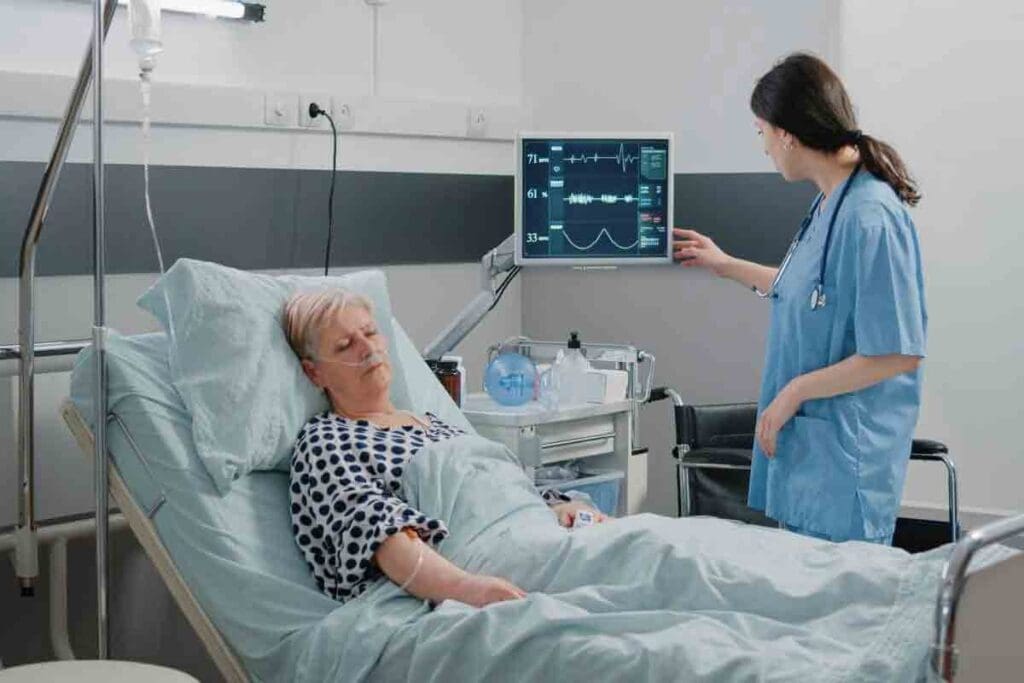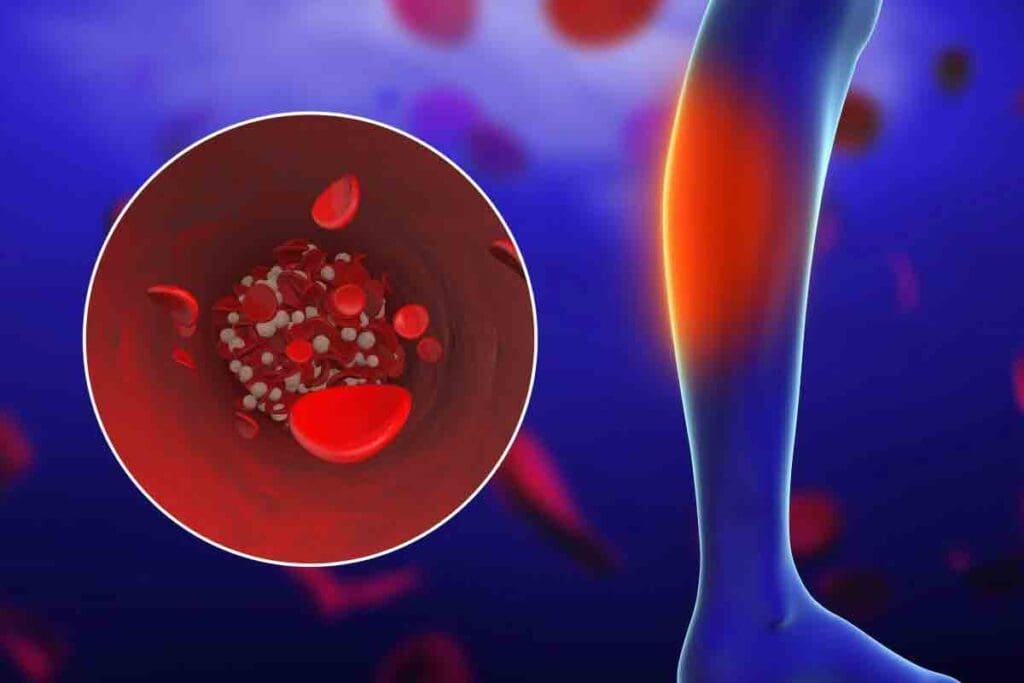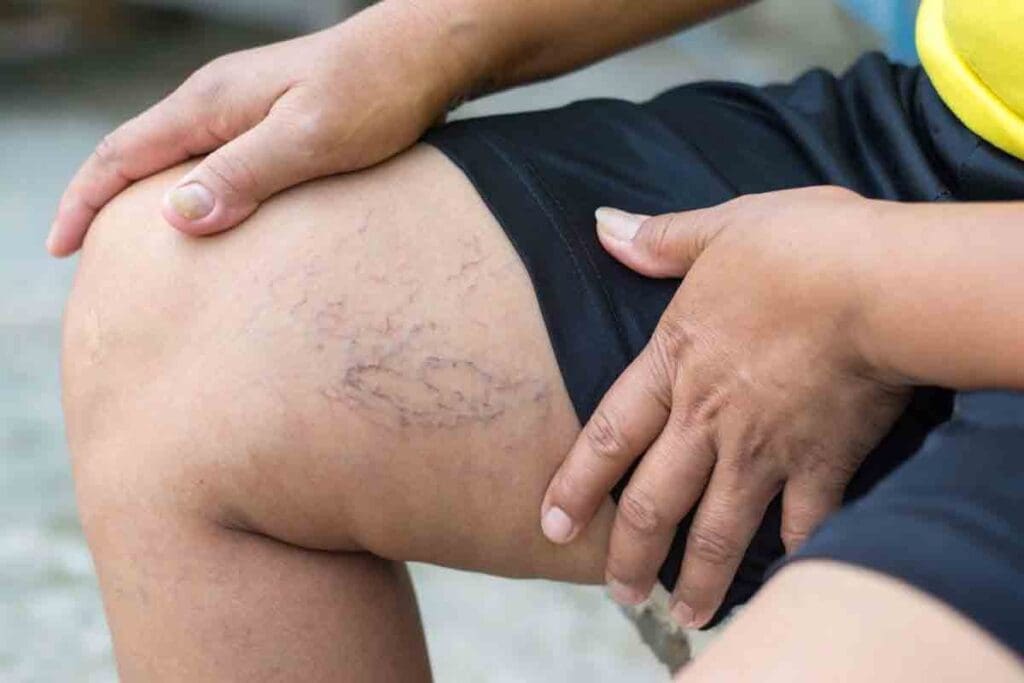Last Updated on November 17, 2025 by Ugurkan Demir

It’s key to know the deep vein thrombosis symptoms to catch it early. Look out for leg pain or tenderness, swelling, warmth, and redness in the affected area. These symptoms often start in one leg, usually the calf or thigh, with a feeling of warmth and skin discoloration such as redness or a bluish hue, depending on skin tone. Sometimes swollen veins are hard or sore to touch. Deep vein thrombosis (DVT) can be serious because clots may travel to the lungs, causing a pulmonary embolism, which requires emergency care. Prompt medical help is essential if you notice these signs, especially if breathing difficulties or chest pain occur.
Knowing about DVT and its symptoms can save lives. Our team of experts is here to give you top-notch care. We’ll help you understand and manage DVT.

Deep vein thrombosis (DVT) is a serious condition. It happens when a blood clot forms in a deep vein, usually in the legs. This is dangerous because the clot can travel to the lungs and cause a pulmonary embolism.
“DVT is a silent killer because it often doesn’t present noticeable symptoms until it’s too late.” Doctors say it’s important to know the risks and how DVT develops. This helps get medical help quickly.
Blood clots in deep veins form from several factors. These include blood stasis, hypercoagulability, and vascular injury. When you’re immobile for a long time, like on a long flight or after surgery, blood pools in deep veins. This increases the risk of clotting.
Hypercoagulability, or an increased tendency for the blood to clot, can be caused by many things. These include genetic conditions, cancer, and certain medications. Vascular injury, like trauma to the leg, can also cause blood clots.
DVT most often happens in the legs, mainly in the calf and thigh. The calf veins are a common place for DVT to start. Clots here are dangerous because they can easily break loose and travel to the lungs.
Things that increase your risk of DVT include being immobile for a long time, recent surgery, cancer, and genetic conditions. Knowing these risk factors and the signs of DVT is key for early treatment.

The main symptoms of DVT include pain or tenderness in the leg. This pain can be very bad and doesn’t get better with rest. Other important signs are:
These signs can mean you have a blood clot. You should not ignore them.
Some people may also have secondary symptoms. These include:
It’s important to know that some people might not notice any symptoms. This is why it’s key to know the risk factors and get checked by a doctor if you think you might have DVT.
Early detection is key to managing DVT well and avoiding serious problems like pulmonary embolism. If you’re feeling any of these symptoms, you should see a doctor right away.
Pain is often the first sign of Deep Vein Thrombosis. It can show up in different ways. Knowing what to look for is key to spotting it early.
The pain from a blood clot in the leg can be different for everyone. Some feel sharp pain, while others have a dull ache or cramp. Experts say the pain might start in the calf and feel like cramping or soreness. This makes it important to watch for any unusual or ongoing leg pain.
Standing or walking can make the pain worse. A study found that the pain gets better when you rest. This can help doctors figure out if you have DVT.
It’s hard to tell DVT pain from muscle cramps because both hurt the leg. But, there are differences. Muscle cramps are usually more focused and might show muscle spasms. DVT pain spreads out and doesn’t show muscle spasms.
DVT pain keeps getting worse, unlike muscle cramp pain which goes away fast. Also, DVT pain often comes with swelling, redness, or warmth in the leg. These signs don’t usually happen with muscle cramps.
“It’s not just the pain; it’s the combination of pain with other symptoms like swelling or redness that should raise concern for DVT.”
Knowing how DVT pain is different from muscle cramps is important. If you have ongoing or severe leg pain, and other symptoms too, you should see a doctor.
A blood clot in the deep veins of your leg can cause swelling and changes in appearance. Swelling happens because blood flow is blocked, leading to fluid buildup.
Swelling from Deep Vein Thrombosis (DVT) follows specific patterns:
DVT swelling doesn’t always hurt, so watch for any changes in your leg’s look.
Other signs can show a blood clot:
Doctors say spotting these signs early is key to avoiding serious problems. Knowing these signs can help you get medical help fast.
If you see any of these symptoms, see a doctor right away for an evaluation and treatment.
Skin changes are a key sign of Deep Vein Thrombosis. They can show up as redness, warmth, or discoloration. A blood clot in a deep vein can change how the skin looks and feels.
One sign of DVT is a change in skin color. The skin above the clot may look reddish or bluish. This is because blood pools behind the clot.
This redness can be confused with other issues like cellulitis. But with DVT, it usually comes with swelling and pain too.
Another sign of DVT is a warmer leg. The area with the clot may feel warm or hot. This is because of the inflammation from the clot.
| Symptom | Description |
| Redness | Skin appears reddish or bluish due to blood pooling |
| Warmth | Affected area feels warm or hot to the touch |
| Discoloration | Change in skin color, potentially indicating a blood clot |
Not everyone with DVT shows all these signs. Some people might have a few symptoms, while others might not notice anything. If you think you have DVT, get medical help right away.
The symptoms of DVT change based on where the blood clot is in the leg. Knowing these symptoms is key for early treatment.
A blood clot in the calf can cause pain or tenderness. This pain can feel like a mild ache or a sharp, severe pain. Swelling in the calf, along with redness or warmth, are common signs too.
Experts say, “Calf DVT symptoms can be subtle. It’s important to watch for any changes in your leg.”
“The presence of a clot in the calf can lead to what is known as ‘pseudo-phlebitis’ syndrome, mimicking other conditions.”
Thigh clots have more noticeable symptoms. Extensive swelling is common, often affecting the whole leg. Pain can be widespread, unlike the focused pain in calf DVT.
Thigh clots are more dangerous because they can break loose and cause a pulmonary embolism. So, seeking medical help quickly is vital if symptoms get worse or don’t go away.
Up to 30% of DVT cases don’t show symptoms, making it a silent danger. Deep Vein Thrombosis can happen without obvious signs. Knowing the risk factors is very important.
Several factors make some DVT cases seem symptom-free. One key reason is that the body can compensate for the blockage caused by the clot, sometimes masking the symptoms. Also, where the clot forms can affect if symptoms are felt; some areas may not cause immediate pain or visible signs.
The risk of asymptomatic DVT is very concerning because it can lead to serious problems, like pulmonary embolism, without warning. This shows why knowing the risk factors and getting screened if you’re at high risk is so important.
Some situations make getting DVT more likely. Knowing these can help you prevent it or get checked early. High-risk situations include:
If you’re in any of these situations, talk to your doctor. They can tell you if you need to get screened and what steps you can take to prevent DVT.
By knowing the risks and acting early, you can greatly lower the danger of DVT. Being aware and getting medical help quickly are key to avoiding serious problems.
It’s important to know the signs of DVT after surgery. This is because surgery can increase the risk of Deep Vein Thrombosis. This risk comes from being immobile for a long time, damage to veins during surgery, and the body’s natural clotting response.
Surgery, like major operations, raises the risk of DVT. This is because of being immobile for a long time, damage to veins, and the body’s clotting response to trauma.
Other factors that can increase the risk of DVT in post-surgical patients include:
Knowing the signs of DVT after surgery is critical. Look out for:
| Symptom | Description |
| Pain or Tenderness | Pain or tenderness in the leg, which may feel like cramping or soreness, often starting in the calf |
| Swelling | Swelling in the affected leg, sometimes accompanied by redness or warmth |
| Skin Changes | Changes in skin color, such as redness or a bluish tint, and warmth to the touch |
If you notice any of these symptoms after surgery, seek medical help right away. Early treatment can prevent serious complications like pulmonary embolism.
Prompt action is essential for managing DVT effectively. If you’re experiencing any post-operative symptoms that concern you, don’t hesitate to contact your healthcare provider.
Knowing the signs of deep vein thrombosis (DVT) is key for quick medical help. We’ve talked about the main symptoms like pain, swelling, and skin changes. If you notice these signs, it’s important to know when to get medical help.
If you think you might have DVT, get emergency care right away. Quick medical attention can greatly improve your treatment and lower the risk of serious problems. Pay attention to your body’s signals and act to keep yourself healthy.
When you go to the doctor, be ready to share your symptoms, health history, and any recent surgeries or hospital stays. This info helps doctors give you the right diagnosis and treatment. By staying informed and alert, you can manage your health and lessen DVT risks.
Symptoms include pain, tenderness, and swelling. The leg might also feel warm and have red or blue skin. You might see prominent veins.
A blood clot can cause pain, like cramping or soreness. It often starts in the calf. The leg might feel tender or painful.
Swelling is common, usually in one leg. The skin might look reddish or bluish. It can also feel warm to the touch.
Yes, you can feel symptoms like pain, tenderness, swelling, and warmth. These are signs of a blood clot.
Yes, they can be serious. They can lead to pulmonary embolism, a life-threatening condition. Getting medical help quickly is important.
Symptoms include pain, tenderness, swelling, redness, and warmth. These signs indicate a blood clot in the calf.
Clots in the thigh cause more swelling than those in the calf.
Yes, some people might not notice symptoms. This is why awareness and screening are key, even in high-risk situations.
Surgery can cause blood clots. To reduce this risk, preventive measures are taken before and after surgery.
If you think you have DVT, seek emergency care right away. Early treatment is key to avoiding serious problems.
Subscribe to our e-newsletter to stay informed about the latest innovations in the world of health and exclusive offers!